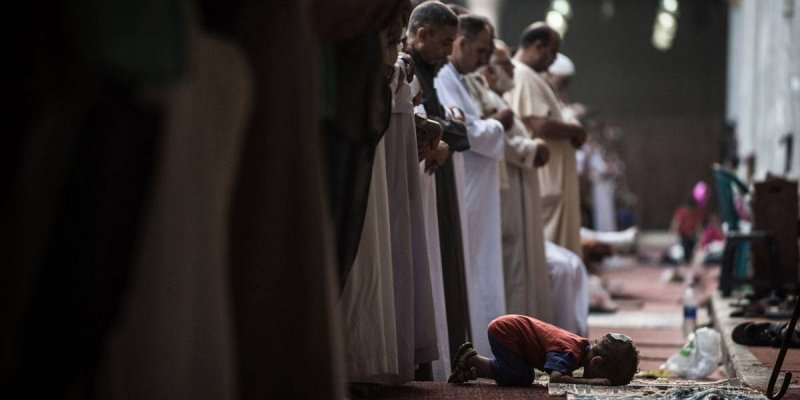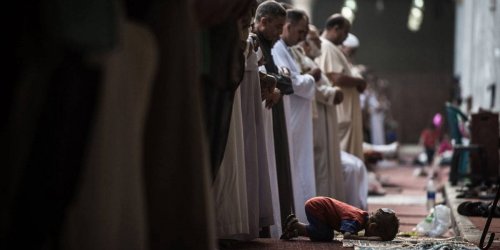Prayer in Islam evolved over the ages, and was repeatedly modified. After Prophet Muhammad’s migration to Medina, the number of prayers was increased, taking the form that Muslims practice today. Only then, Muslims could pray in public after being forced to pray in secret, fearing persecution by Quraysh in Mecca.
When were Muslims commanded to pray?
There are numerous narratives about the history, emergence, and evolution of prayer in Islam, one of the basic pillars of the faith.
According to As-Seerah Al Halabiyah, the Prophet and his people had not been commanded to pray before his night journey and ascension to heaven. In his book “Tuhfatu'l Muhtaj li Sharh Al-Minhaj”, Ibn Hajar Al-Haythami further proves this when he says that “people were only commanded to believe in the oneness of the Creator, and the only prayers they were commanded to perform were those mentioned in Surat Al-Muzammil”. This refers to night prayers, performed by Prophet Muhammad and later reduced in the Koran to half.
However, others affirm that people were commanded to pray when Prophet Muhammad received his first revelation in the Hira Cave, where he had been used to worshipping God in solitude before the spread of Islam. Ibn Ishaq writes:
“when the Prophet was commanded to pray, Archangel Gabriel came to him when he was atop a mountain in Mecca, and pointed to a corner of the valley, where a spring of water later gushed out from the rocks. The Prophet watched as Gabriel performed ablution, showing him how to purify oneself for prayer, and then did the same. Gabriel got up, prayed with him and left. Prophet Muhammad later went to his wife, Khadija, and performed ablution to show her what he had learned from Gabriel. He prayed with her, just like Gabriel had prayed with him, and then she prayed his prayer”.
This narrative, however, runs against what the Koran mentions about ablution in Surat Al-Ma’idah. Describing ablution and purification for prayer, the Koran says “O you who believe! When you get ready for ritual prayer [šalāt], wash your faces, and your hands up to the elbows, and lightly rub your heads and (wash) your feet up to the ankles.”
The aforementioned Surat was revealed after the Prophet’s migration to Medina, meaning it is incompatible with Ibn Ishaq’s narrative. The latter believes that people were commanded to perform ablution when they were first commanded to pray.
After reflecting on Prophet Muhammad’s state of mind at the time of revelation, the narrative suggesting that prayer was commanded at that point is unlikely to be true. The Prophet felt hesitant, frightened and uncomfortable, and was overwhelmed with doubts and fears about what had really appeared before his eyes in the cave.
According to one Hadith, the Prophet, perplexed after his first encounter with Archangel Gabriel, told Khadija, “I feared that something might happen to me”. She took him to Waraqa Ibn Nawfal, a Christian priest, who affirmed that what the Prophet had seen was the same angel whom Allah had sent to Prophet Moses and other prophets. He confirmed he had seen an angel from heaven.
The Prophet’s Prayer in Mecca
According to Dr. Jawad Ali’s book The History of Prayer in Islam, the Prophet’s first prayer in Mecca consisted of two cycles (Rakaah). The author mentioned that “the prophet left his home shortly after the sunrise to pray Duhr (forenoon prayer), which he could perform in the Kaaba, as Quraysh did not oppose it. When it was time for Asr (afternoon prayer), he and his friends would disperse in alleys to pray either alone or in pairs”.
As shown in books covering the Prophet’s life, Prophet Muhammad performed two prayers a day in Mecca, consisting of two cycles each. He prayed in the forenoon and the afternoon, as mentioned in Al-Maqrizi’s book “Imta’ Al-Isma’”. “A prayer before the sunrise and another before the sun sets”, writes Maqrizi. According to Seerat Ibn Hisham, Muqatel bin Suleiman said that “God commanded believers in the early days of Islam to pray two-cycle prayers; when the day begins and when it ends”.
As described by As-Seerah Al Halabiyah , this two-cycle prayer was the obligatory prayer during the life of Khadija, the Prophet’s wife, and until her death before the migration. Following the migration to Medina, new prayers that had not been obligatory in Mecca were introduced. Prayers were doubled for Muslims, and two additional cycles, known as Salat Al-Hadr, were introduced.
The Emergence of the Five Prayers
According to Ibn Sayyid Al-Nas in “Oyoun al Athar”, the five prayers that were made obligatory on the night of the Prophet’s ascension consisted of two cycles each. The first reference to the five prayers in Islam was made during the Prophet’s miraculous journey to Jerusalem and ascension to heaven.
In Tareekh Al-Tabari we read:
“when he reached the seventh heaven, fifty prayers a day were made obligatory. The Prophet, peace be upon him, said I returned and passed by Moses bin Omran, who was a good companion, and he asked me: how many prayers were made obligatory?. I said fifty prayers a day and he said that “prayer is a burden and your followers are weak, go back to your God and appeal for a reduction for you and your people. I went back and asked God for a reduction for me and my people. He reduced them by ten and I left. I came across Moses again and he repeated what he had said. I went back and asked God for a reduction for me and my people. He reduced them by another ten. I returned and came across Moses, who repeated what he had said. I went back and asked God for a reduction for me and my people. He reduced them by another ten. I came across Moses and he kept repeating what he had said. He told me to go back and appeal for a reduction again until I had only five prayers every day and night. I returned to Moses and told him I had spoken to God and asked him until I had felt ashamed, whoever performed the prayers faithfully will be granted the reward of 50 prayers”.
Number of Cycles (Rakaah)
During Prophet Muhammad’s first year in Medina, Duhr, Asr and Isha prayers were all lengthened to four cycles each, while they had consisted of two cycles when prayed on time and during travel before. However, the Prophet continued to pray the morning prayer as he had done before and added one cycle to Maghreb, according to the author of “The History of Prayer in Islam”, which led to the final form of prayer that Muslims practice today.
Abdullah Bahjat, a researcher specialized in Islamic studies and text at “Mouminon without borders”, said that “just like other affairs in Islamic jurisprudence, prayer went through different stages; the general atmosphere in Mecca, such as violence, instability of Da’wa, the limited number of followers and persecution by Quraysh, did not help people establish religion as the Prophet had hoped, and so he was only seeking a commitment from these new believers to their religion”.
Prayer in Other Religions
Thanks to their interaction with other people, the society in Mecca knew prayer and did not perceive it as a “novel idea”.
Mentioned in the Koran, Mandaeism was one of the religions of Mesopotamia. Followers of this religion prayed three times: shortly before the sunrise, at noon and when the sun sets. As mentioned by Shahrastani in his book “Milal Wa Nihal”, they kneeled and prostrated in their prayers too.
In his book “The Story of Civilization”, American Historian Will Durant speaks of an association between the five prayers and the Prophet’s interaction with Persians, who were also known for performing five prayers. He says that “they had been two-cycle five prayers in the beginning until the Prophet migrated to Medina. The reason why he chose five prayers is that he had interacted with Persians during his commercial activity, and learned from them that they prayed five times a day”.
During the Meccan period, Muslims could perform Duhr prayer, one of the two prayers Muslims were commanded to pray, in Kaaba without Quraysh’s opposition.
In his book “The History of Prayer in Islam”, Jawad Ali writes that “if there is no evidence that Duhr prayer existed in pre-Islam era, then this is a proof that Qurasyh knew this prayer and let the Prophet perform it without interference”.
Spending the night praying, reciting Koran and supplicating, as the Prophet had done after Islam and before the Koran made it easier later, was an act of worship that Judaism and Christianity both had.
In the Book of Psalms, a verse reads: “at midnight I will rise to give thanks to You, Because of Your righteous judgments”. Prophet David also spent half of the night, reading, chanting and praising God as mentioned in “Tarikh Al-Yacubi”.
According to As-Seerah, Prophet Muhammad also stayed in solitude for a month or less in Hira Cave, an act that was also familiar among a group known as “Hunaifiyyah” in Mecca. They rejected idolatry, and did not adhere to any other religion at the time. In As-Seerah, they were described as “a group of people seeking Abraham’s religion; they abstained from idolatry, dead animals and sacrifices whose blood was shed on idols. They said they worshipped the God of Abraham, and Waraqa Ibn Nawfal was one of them. No clear news or descriptions were mentioned about the form of their worship and prayers”.
No Prayer without Al-Fatihah
Surat Al-Fatihah remains an integral part of any prayer in Islam, followed by the recital of different verses of the Koran. It remains the most important pillar for Muslims as the Prophet was quoted as saying that “Whoever offers a prayer in which he does not recite Umm al-Kitaab (i.e., al-Fatihah), it is defective”. In this light, is a prayer complete and valid without Al-Fatihah?
Was Al-Fatihah revealed when the first act of prayer emerged? It is well known that Al-Fatihah was not the first Surat to be revealed to the Prophet. In addition, there are conflicting narratives on the timing of its revelation. It was said to be a “Meccan and Medinan Surat”, meaning that the prayer did not necessarily begin with reciting Al-Fatihah.
According to Jawad Ali, “when Qibla (the direction of prayer) was changed, Archangel Gabriel told the Prophet that “Al-Fatihah is an integral part of the prayer”, and that was in the second Hijra year”.
Raseef22 is a not for profit entity. Our focus is on quality journalism. Every contribution to the NasRaseef membership goes directly towards journalism production. We stand independent, not accepting corporate sponsorships, sponsored content or political funding.
Support our mission to keep Raseef22 available to all readers by clicking here!
Interested in writing with us? Check our pitch process here!






